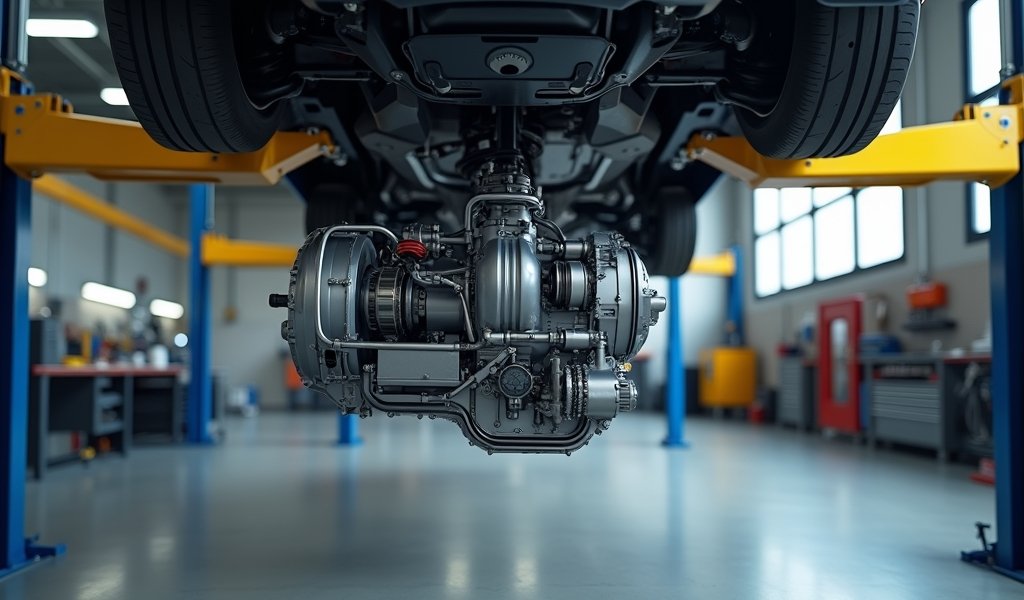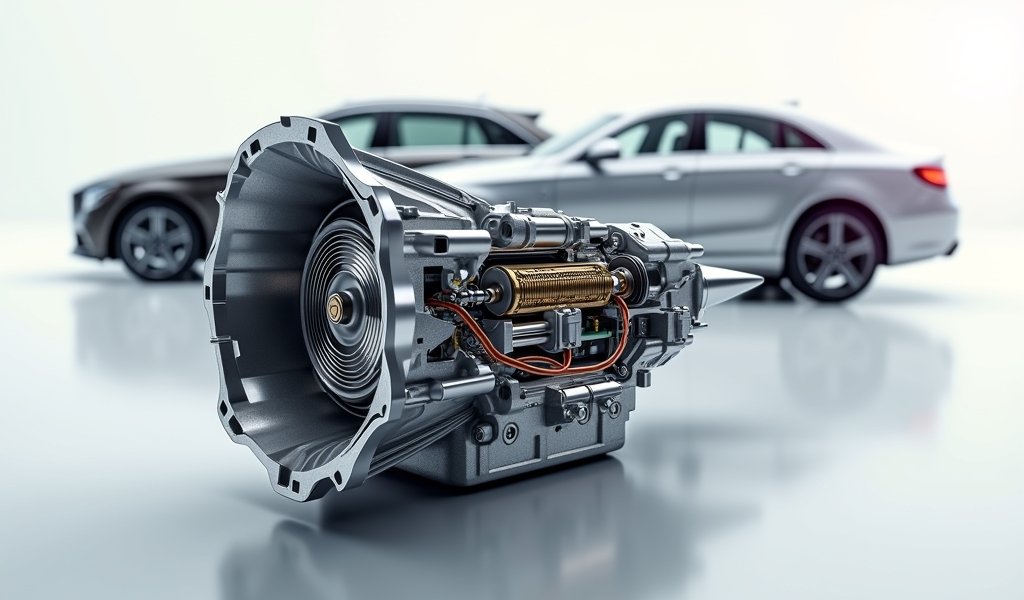Overview
A transmission solenoid pack is the crucial electronic component that controls fluid flow for gear shifting in automatic transmissions, with problems typically arising from contaminated fluid, electrical issues, or wear. Regular maintenance—particularly proper fluid service—is the key to preventing costly solenoid failures, which manifest through symptoms like delayed shifting, gear slipping, or getting stuck in a single gear.
Table of Contents
- What Is a Transmission Solenoid Pack?
- How Transmission Solenoid Packs Work
- Types of Transmission Solenoids
- Common Solenoid Pack Problems
- Maintenance Tips
- Repair vs. Replacement
- Conclusion
- Frequently Asked Questions
What Is a Transmission Solenoid Pack?
If you’ve ever marveled at how your car shifts gears without you having to touch a clutch pedal, you can thank your automatic transmission solenoid pack. This component is essentially the brain behind your transmission’s operation, though most drivers never think about it until something goes wrong.
The automatic transmission solenoid pack is a collection of electronically controlled valves housed together in a single unit. These valves regulate the flow and pressure of transmission fluid throughout your transmission system, determining when and how your car shifts gears. It’s the critical link between your car’s computer and the physical action of changing gears.
Located inside the transmission’s valve body, the solenoid pack typically contains multiple individual solenoids (usually between 4-10, depending on your vehicle). Each solenoid controls a specific function or gear change. Without these solenoids working properly, your transmission would be unable to shift smoothly—or possibly shift at all.
Modern vehicles integrate these solenoid packs with sophisticated computer systems. Your car’s Transmission Control Module (TCM) constantly monitors data like vehicle speed, throttle position, and engine load, then sends electrical signals to the appropriate solenoids to initiate gear changes. This electronic management is what makes today’s transmissions so smooth and efficient compared to older models.
Think of the solenoid pack as the postal service of your transmission—it makes sure hydraulic pressure (the “mail”) gets delivered to exactly the right places at precisely the right times. When it works correctly, you never notice it. When it doesn’t, your driving experience deteriorates quickly.

How Transmission Solenoid Packs Work
The magic behind your automatic transmission solenoid pack lies in its elegant simplicity. Each solenoid operates on a basic electromagnetic principle: when electricity flows through the solenoid’s wire coil, it creates a magnetic field that moves a metal plunger inside the solenoid.
This movement is small—usually just a few millimeters—but it’s enough to either open or close tiny fluid passages. When open, transmission fluid flows through; when closed, the fluid is redirected. It’s this precise control of fluid flow that enables your transmission to engage different gear sets at the right moments.
Here’s what happens during a typical upshift from first to second gear:
- Your car’s computer senses you’ve reached an appropriate speed for shifting
- It sends an electrical signal to specific solenoids in the pack
- These solenoids activate, changing their positions
- Transmission fluid pressure is redirected to disengage first gear components
- Simultaneously, pressure is applied to engage second gear components
- The entire process takes place in milliseconds
What’s truly impressive is how this system adapts to your driving style. If you’re accelerating hard, the solenoids will adjust pressure to provide firmer, quicker shifts. During gentle cruising, they’ll modulate for smoother, almost imperceptible gear changes. This adaptability comes from the car’s diagnostic systems constantly feeding information to the transmission control module.
The solenoid pack must operate in an incredibly hostile environment. It’s submerged in transmission fluid, exposed to temperatures that can exceed 200°F, and must perform flawlessly thousands of times over your vehicle’s lifetime. This challenging environment explains why solenoids eventually wear out or develop problems in higher-mileage vehicles.
According to research from the Automatic Transmission Rebuilders Association, solenoid-related issues account for approximately 15% of all transmission problems, making them one of the most common causes of transmission malfunctions.
Types of Transmission Solenoids
Not all solenoids in your transmission pack serve the same purpose. Understanding the different types can help you better comprehend what might be failing when problems arise.
Shift Solenoids
Shift solenoids are the workhorses of your transmission. They directly control which gear your transmission engages by directing fluid to specific clutch packs or bands. Most transmissions have multiple shift solenoids—typically labeled A, B, C, and so on—that work in various combinations to select different gears.
For example, in many transmissions, solenoid A might be energized for first and third gears but de-energized for second and fourth. When a shift solenoid fails, you’ll often lose specific gears or experience erratic shifting between certain gears.
Pressure Control Solenoids
While shift solenoids determine which gear to engage, pressure control solenoids determine how that engagement feels. These solenoids modulate the hydraulic pressure applied during shifts, affecting the smoothness of gear changes.
Too little pressure can cause slippage and a soft, sluggish shift. Too much pressure results in harsh, jarring shifts that can damage components over time. Pressure control solenoids provide the finesse in your transmission’s operation.
Torque Converter Clutch Solenoids
This specialized solenoid controls the engagement of your torque converter’s lockup clutch. When you’re cruising at highway speeds, this clutch creates a direct mechanical connection between your engine and transmission, eliminating the fluid coupling of the torque converter.
This lockup function significantly improves fuel economy by reducing heat and energy loss. When the torque converter clutch solenoid fails, you’ll often notice decreased fuel economy and increased transmission temperature during highway driving.
EPC Solenoids
The Electronic Pressure Control (EPC) solenoid is found in many modern transmissions. It continuously varies the main line pressure throughout the transmission based on operating conditions. Think of it as the master pressure regulator for the entire system.
When functioning properly, the EPC solenoid ensures your transmission has just enough pressure for current conditions—not too much (which wastes energy) and not too little (which causes excessive wear).
Different vehicle manufacturers implement these solenoid types in various ways. A 6-speed GM transmission might use a completely different solenoid arrangement than a 6-speed ZF transmission used in many European vehicles, even though they perform similar functions. This variation is why transmission repair services require specialized knowledge for different vehicle makes.
Common Solenoid Pack Problems
After working on thousands of transmissions, I’ve seen the same solenoid-related issues appear time and again. Recognizing these symptoms early can save you from catastrophic transmission failure down the road.
Warning Signs
Your transmission is trying to tell you something when you experience:
- Delayed or harsh shifting between specific gears
- Transmission slipping or “hunting” between gears
- Vehicle stuck in one gear (often called “limp mode”)
- Complete failure to shift into certain gears
- Illuminated check engine light with transmission-related codes
- Erratic shifting patterns that weren’t present before
- Transmission warning light on your dashboard
These symptoms don’t always mean your solenoids are bad, but they’re often the first suspects in modern transmissions. A proper diagnosis using a scanner that can access transmission data is essential for confirming solenoid issues.
Common Causes of Failure
Solenoids typically fail for one of several reasons:
Contaminated transmission fluid is perhaps the most common culprit. As your transmission wears internally, it produces tiny metal particles that circulate in the fluid. These particles can lodge in solenoid valves, preventing them from fully opening or closing. Even small debris can cause significant performance issues.
Electrical problems account for many solenoid failures. The wiring harnesses connecting to solenoid packs are subjected to heat, vibration, and sometimes fluid exposure. Over time, connectors can corrode or wires can short out. Sometimes the internal coil windings in the solenoid itself break down, causing resistance issues.
Physical wear affects the mechanical parts of solenoids. The plungers and valve bodies inside solenoids can develop scoring or wear patterns that prevent proper sealing. This wear is accelerated when transmission fluid becomes degraded or contaminated.
Overheating is particularly damaging to solenoids. Excessive heat breaks down the insulation on solenoid windings and damages the plastic components. Transmission overheating can occur during heavy towing, in stop-and-go traffic, or when fluid levels are low.
According to transmission repair specialists, approximately 65% of solenoid failures could be prevented with proper fluid maintenance. This simple statistic highlights why regular transmission service is so critical.

Maintenance Tips
After years of rebuilding transmissions, I’ve come to one inescapable conclusion: proper maintenance could prevent most of the catastrophic failures I see. Here’s how to keep your automatic transmission solenoid pack healthy for the long haul.
Fluid Maintenance
Your transmission fluid is the lifeblood of your solenoid pack. Unlike engine oil, transmission fluid doesn’t just lubricate—it’s the actual hydraulic medium that transfers power through your transmission. Old, degraded fluid can’t properly control solenoid functions.
Most manufacturers recommend changing transmission fluid every 30,000-60,000 miles, though many advertise their transmissions as “filled for life.” Let me be clear: there is no such thing as “lifetime” transmission fluid. Even the best synthetic fluids break down over time.
When changing fluid, always use the exact type specified for your transmission. Modern transmissions use highly specialized fluids with specific friction modifiers and additive packages. Using the wrong fluid can cause shifting problems even with perfectly functional solenoids.
Check Your Fluid Regularly
Between fluid changes, periodically check both the level and condition of your transmission fluid. Healthy fluid should be clear with a reddish tint and should not smell burnt. If your fluid is brown or black, has a burnt smell, or contains visible particles, your solenoids are likely already being damaged.
Low fluid levels can cause solenoids to malfunction by allowing air into the hydraulic system. Check your fluid level with the engine running and the transmission at operating temperature for accurate readings.
Address Minor Issues Promptly
Transmission problems rarely improve on their own. That occasional harsh shift or momentary hesitation is likely your transmission’s first cry for help. Addressing these minor symptoms early often means you’re fixing a solenoid issue before it leads to mechanical damage.
Most vehicles store transmission fault codes even before they illuminate a check engine light. Periodic scanning can reveal developing issues before they become noticeable in everyday driving.
Drive Conscientiously
Your driving habits directly affect solenoid longevity. Consider these practices:
- Allow your transmission to warm up before demanding driving, especially in cold weather
- Avoid prolonged “riding” of the brakes while in drive (like holding position on an incline)
- When towing or carrying heavy loads, consider using an auxiliary transmission cooler
- Come to a complete stop before shifting between drive and reverse
- Use lower gears for extended downhill driving rather than riding the brakes
These simple habits reduce stress on your transmission’s solenoids and hydraulic system, potentially adding years to their functional life.
Repair vs. Replacement
When solenoid problems arise, you’ll face the repair-or-replace dilemma. Here’s what you need to know to make an informed decision.
Diagnosing the Problem
Before deciding on any repair, get a proper diagnosis. Modern scan tools can often identify which specific solenoid is malfunctioning through transmission error codes and live data. Sometimes what seems like a solenoid issue might actually be a mechanical problem elsewhere in the transmission.
Codes in the P0750-P0770 range typically indicate shift solenoid problems, while P0740 often relates to the torque converter clutch solenoid. These codes provide valuable clues, but they’re not definitive diagnoses on their own.
Repair Options
You generally have three options when facing solenoid issues:
Replace individual solenoids: In some vehicles, individual solenoids can be replaced without removing the entire transmission. This approach is most cost-effective when only one solenoid is failing and the transmission otherwise performs well. Expect to pay $150-400 for a single solenoid replacement, including parts and labor.
Replace the entire solenoid pack: Many shops recommend replacing the complete solenoid pack as a unit, even if only one solenoid is malfunctioning. This preventive approach makes sense for higher-mileage vehicles, as solenoids tend to fail at similar intervals. A complete solenoid pack replacement typically costs $400-1,000 depending on your vehicle.
Transmission rebuild/replacement: If your transmission has accumulated significant mileage or shows signs of mechanical wear beyond the solenoids, a complete rebuild or replacement might be more economical long-term. While much more expensive ($1,500-4,000+), this addresses all potential issues at once.
DIY Possibilities
For the mechanically inclined, solenoid replacement is within reach on many vehicles. The procedure generally involves dropping the transmission pan, removing the valve body, and replacing the solenoid pack. However, be aware that this job requires:
- Moderate to advanced mechanical skills
- Proper tools and work space
- A factory service manual or reliable repair information
- Meticulous cleanliness to prevent debris from contaminating the transmission
Some newer transmissions also require computer programming or adaptation procedures after solenoid replacement, which may not be possible without dealer-level equipment.
Making the Decision
Consider these factors when deciding your course of action:
- Vehicle age and value: Expensive repairs make less sense on older, lower-value vehicles
- Transmission mileage: Higher-mileage transmissions likely have additional wear beyond the solenoids
- Prior transmission service history: Well-maintained transmissions are better candidates for solenoid-only repairs
- How long you plan to keep the vehicle: More comprehensive repairs make sense for vehicles you’ll keep long-term
When in doubt, seek a second opinion from a transmission specialist rather than a general repair shop. Transmission-specific expertise can make the difference between a successful repair and recurring problems.
Conclusion
Your automatic transmission solenoid pack may be hidden from view, but it’s the unsung hero that makes modern automatic transmissions possible. This sophisticated component transforms simple electrical signals into the smooth, precise gear changes we’ve come to expect from today’s vehicles.
The key takeaway should be the importance of preventative maintenance. Regular fluid services cost far less than solenoid pack replacements or transmission rebuilds. By maintaining clean fluid at the proper level, you’re providing the best possible environment for your solenoids to function reliably for years to come.
Early intervention is crucial when symptoms first appear. The difference between a simple solenoid replacement and a complete transmission rebuild often comes down to how quickly you address initial warning signs like hesitation or erratic shifting.
Whether you’re driving a family sedan, a rugged pickup, or a luxury SUV, the principles of solenoid pack operation and maintenance remain similar. Understanding this critical component helps you become a more informed vehicle owner, potentially saving you thousands in repair costs over your vehicle’s lifetime.
Remember that every mile you drive with contaminated transmission fluid or ignored warning signs is potentially reducing the life of your transmission. With today’s vehicles routinely lasting well beyond 200,000 miles with proper care, investing in transmission maintenance is simply smart economics.
Take care of your transmission solenoid pack, and it will take care of you—delivering thousands of smooth, trouble-free shifts for many years to come.
Frequently Asked Questions
How much does it cost to replace a transmission solenoid pack?
Replacement costs typically range from $400 to $1,000 for parts and labor, depending on your vehicle make and model. Higher-end luxury vehicles and those requiring significant disassembly to access the solenoid pack may cost more.
Can you drive with a bad transmission solenoid?
While technically possible in some cases, driving with a bad solenoid risks causing more extensive and expensive damage to your transmission. Your vehicle may also become stuck in a single gear or “limp mode,” severely limiting drivability.
How do I know if my transmission solenoid is bad?
Common symptoms include delayed or harsh shifting, inability to shift into certain gears, and transmission warning lights on your dashboard. Diagnostic trouble codes retrieved from your vehicle’s computer can help confirm solenoid-specific issues.
Can transmission solenoids be cleaned instead of replaced?
While some technicians attempt cleaning solenoids, it’s generally not recommended as a reliable repair. Internal electrical or mechanical damage to solenoids cannot be resolved by cleaning, and contamination often returns quickly if the root cause isn’t addressed.
How long do transmission solenoids typically last?
With proper maintenance, transmission solenoids often last 100,000 to 150,000 miles. Factors affecting longevity include fluid maintenance, driving habits, and operating conditions such as towing or stop-and-go traffic.

